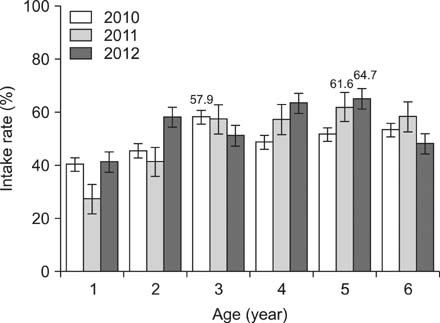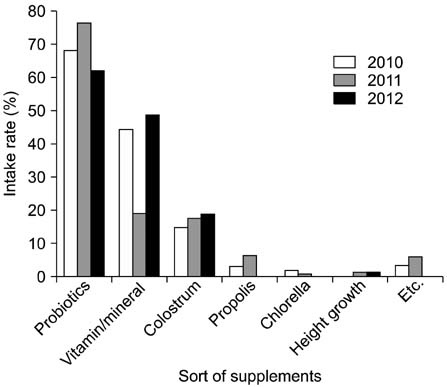Pediatr Gastroenterol Hepatol Nutr.
2014 Sep;17(3):178-185. 10.5223/pghn.2014.17.3.178.
The Status of Dietary Supplements Intake in Korean Preschool Children: Data from the Korea National Health and Nutrition Examination Survey 2010-2012
- Affiliations
-
- 1Department of Pediatrics, Dankook University College of Medicine, Cheonan, Korea. pdlks@hanmail.net
- KMID: 1803118
- DOI: http://doi.org/10.5223/pghn.2014.17.3.178
Abstract
- PURPOSE
The use of dietary supplements (DS) has increased in most nations. We investigated the amount of DS intake in the Korean population by analyzing a national survey, to support the preparation of a national institutional strategy regarding DS intake and marketing.
METHODS
The data of the fifth Korea National Health and Nutrition Examination Survey (a year between 2010 and 2012) were investigated, analyzing the rate of DS intake, and the characteristics of the intake group and non-intake group in Korean preschool children.
RESULTS
The intake rate of DS was 49.0-54.2% (1,313,874-1,491,240) and 19.6-30.3% (250,603-421,922) in children from 1 to 6 years old and in those less than 1 year, respectively, from 2010 to 2012. The highest intake rate was observed in the age group of five. The mean age was significantly higher in the DS intake group than in the non-intake group. Intake of essential nutrients, minerals, and vitamins were also higher in the DS intake group. The level of family income was significantly associated with the intake rate (p<0.001). In children less than 1 year, probiotics accounted for the highest intake of DS.
CONCLUSION
Korean preschool children have high consumption of DS. Therefore, problems may arise from the waste of money purchasing unnecessary DS, and from the overuse of DS in preschoolers who do not require DS intake. We hope these results can be used to produce an appropriate national institutional strategy regarding DS intake and marketing.
Keyword
MeSH Terms
Figure
Cited by 1 articles
-
Micronutrients Are Not Deficient in Children with Nonorganic Failure to Thrive
Junho Hong, Sowon Park, Yunkoo Kang, Hong Koh, Seung Kim
Pediatr Gastroenterol Hepatol Nutr. 2019;22(2):181-188. doi: 10.5223/pghn.2019.22.2.181.
Reference
-
1. Park HA, Kim SY. Nutritional supplements. J Korean Med Assoc. 2012; 55:889–897.
Article2. Kim HS, Lee HY, Kim MK. Dietary supplements use and related factors of preschoolers in 3 korean cities. Pediatr Gastroenterol Hepatol Nutr. 2013; 16:104–115.
Article3. Yoon JY, Park HA, Kang JH, Kim KW, Hur YI, Park JJ, et al. Prevalence of dietary supplement use in Korean children and adolescents: insights from Korea National Health and Nutrition Examination Survey 2007-2009. J Korean Med Sci. 2012; 27:512–517.
Article4. Bailey RL, Gahche JJ, Lentino CV, Dwyer JT, Engel JS, Thomas PR, et al. Dietary supplement use in the United States, 2003-2006. J Nutr. 2011; 141:261–266.
Article5. Shaikh U, Byrd RS, Auinger P. Vitamin and mineral supplement use by children and adolescents in the 1999-2004 National Health and Nutrition Examination Survey: relationship with nutrition, food security, physical activity, and health care access. Arch Pediatr Adolesc Med. 2009; 163:150–157.
Article6. Bailey RL, Gahche JJ, Thomas PR, Dwyer JT. Why US children use dietary supplements. Pediatr Res. 2013; 74:737–741.
Article7. Lutter CK, Rivera JA. Nutritional status of infants and young children and characteristics of their diets. J Nutr. 2003; 133:2941S–2949S.
Article8. Korean Nutrition Society. 2010 dietary reference intakes for Koreans. Seoul: Korean Nutrition Society;2010. p. 25–46.9. Allen RE, Myers AL. Nutrition in toddlers. Am Fam Physician. 2006; 74:1527–1532.10. Sato Y, Yamagishi A, Hashimoto Y, Virgona N, Hoshiyama Y, Umegaki K. Use of dietary supplements among preschool children in Japan. J Nutr Sci Vitaminol (Tokyo). 2009; 55:317–325.
Article11. Picciano MF, Dwyer JT, Radimer KL, Wilson DH, Fisher KD, Thomas PR, et al. Dietary supplement use among infants, children, and adolescents in the United States, 1999-2002. Arch Pediatr Adolesc Med. 2007; 161:978–985.
Article12. Dwyer J, Nahin RL, Rogers GT, Barnes PM, Jacques PM, Sempos CT, et al. Prevalence and predictors of children's dietary supplement use: the 2007 National Health Interview Survey. Am J Clin Nutr. 2013; 97:1331–1337.
Article13. Morin KH. Vitamin and supplement use in infants and toddlers. MCN Am J Matern Child Nurs. 2008; 33:389.
Article14. Lee KS. Dietary supplements of toddlers. In : Proceeding of the 7th symposium of the Korean Society of Pediatric Gastroenterology and Nutrition; Seongnam: The Korean Society of Pediatric Gastroenterology, Hepatology and Nutrition;2013. p. 1–5.15. Ball SD, Kertesz D, Moyer-Mileur LJ. Dietary supplement use is prevalent among children with a chronic illness. J Am Diet Assoc. 2005; 105:78–84.
Article16. Kim YH, Lee SG, Kim SH, Song YJ, Chung JY, Park MJ. Nutritional status of Korean toddlers: From the Korean National Health and Nutrition Examination Survey 2007~2009. Korean J Pediatr Gastroenterol Nutr. 2011; 14:161–170.
Article17. Lee J, Kim D, Lee Y, Koh E, Jang Y, Lee H, et al. Influencing factors on the dietary supplements consumption among children in Korea. Korean J Community Nutr. 2011; 16:740–750.
Article18. Briefel R, Hanson C, Fox MK, Novak T, Ziegler P. Feeding infants and toddlers study: do vitamin and mineral supplements contribute to nutrient adequacy or excess among US infants and toddlers? J Am Diet Assoc. 2006; 106:1 Suppl 1. S52–S65.
Article19. Lubetzky R, Mandel D, Mimouni FB. Vitamin and mineral supplementation of term infants: are they necessary? World Rev Nutr Diet. 2013; 108:79–85.
Article20. Kim MK, Jung JH, Min DL, Lee HJ, Park EJ. Study to examine the awareness of the parents, whose children are attending an elementary school in Gyeonggi-do, on herbal medication and health functional food. J Korean Orient Pediatr. 2011; 25:111–118.
Article
- Full Text Links
- Actions
-
Cited
- CITED
-
- Close
- Share
- Similar articles
-
- Nutritional Status of Korean Toddlers: From the Korean National Health and Nutrition Examination Survey 2007~2009
- Food sources of zinc and nutritional status with usual dietary zinc intake in Korean toddlers and preschool children
- A Study on the Dietary Behavior of Korean Adults: Focus on Dietary Supplement Intake, Household Size, and COVID-19
- Top 10 Dietary Supplements of Korean Adults from the 4th Korea National Health and Nutrition Examination Survey
- Dietary intake and nutritional status of Korean children and adolescents: a review of national survey data




